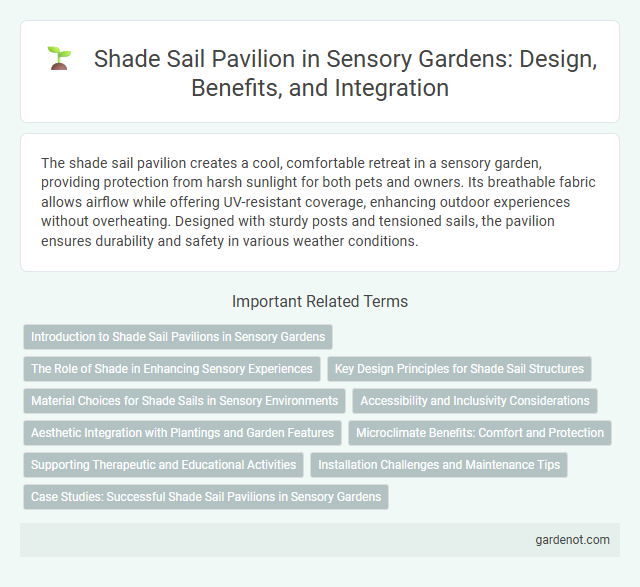The shade sail pavilion creates a cool, comfortable retreat in a sensory garden, providing protection from harsh sunlight for both pets and owners. Its breathable fabric allows airflow while offering UV-resistant coverage, enhancing outdoor experiences without overheating. Designed with sturdy posts and tensioned sails, the pavilion ensures durability and safety in various weather conditions.
Introduction to Shade Sail Pavilions in Sensory Gardens
Shade sail pavilions in sensory gardens provide essential shaded areas that enhance comfort and encourage prolonged engagement with sensory elements. Constructed from durable, UV-resistant fabric, these structures protect visitors from sun exposure while maintaining airflow and aesthetic appeal. Their strategic installation supports inclusive outdoor experiences by creating calm, cool gathering spaces for all ages and abilities.
The Role of Shade in Enhancing Sensory Experiences
Shade sail pavilions in sensory gardens create a controlled environment that reduces harsh sunlight, allowing visitors to engage more comfortably with tactile, olfactory, and auditory stimuli. The filtered light under shade sails enhances the perception of colors and textures of plants, while also helping to regulate temperature, making sensory exploration more enjoyable and accessible. By providing shelter from direct sun exposure, shade structures protect sensitive plants and delicate materials, ensuring the garden's sensory elements remain vibrant and effective year-round.
Key Design Principles for Shade Sail Structures
Shade sail pavilions optimize outdoor sensory gardens by integrating tensioned fabric membranes anchored to sturdy posts or existing structures, providing UV protection and cooling shade. Key design principles for shade sail structures include selecting breathable, water-resistant materials that ensure durability while allowing airflow, precise tensioning for wind resistance, and strategic placement to maximize sun coverage during peak hours. Incorporating flexible anchor points and varying sail shapes enhances aesthetic appeal and functional adaptability, creating comfortable, shaded environments that support sensory exploration.
Material Choices for Shade Sails in Sensory Environments
Material choices for shade sails in sensory gardens prioritize breathable, UV-resistant fabrics like high-density polyethylene (HDPE) to ensure optimal sun protection and airflow for comfort. These materials are lightweight, durable, and designed to withstand various weather conditions while minimizing heat buildup beneath the pavilion. Incorporating soft, non-toxic, and easily cleaned textiles enhances tactile experiences and maintains a safe environment for all sensory users.
Accessibility and Inclusivity Considerations
Shade sail pavilions in sensory gardens feature wide, ramped entryways and smooth, non-slip surfaces to ensure wheelchair accessibility and easy navigation for all visitors. Tactile indicators and contrasting colors are incorporated to assist individuals with visual impairments in locating shaded areas independently. Seating arrangements are thoughtfully spaced to accommodate mobility aids, promoting inclusivity and comfort across diverse sensory and physical needs.
Aesthetic Integration with Plantings and Garden Features
Shade sail pavilions create a striking visual contrast while seamlessly blending with lush plantings, enhancing the sensory garden's natural ambiance. Their flowing fabric forms complement organic shapes and textures, adding dynamic architectural interest without overwhelming greenery or floral displays. Strategic placement near flowering beds and textured foliage amplifies color vibrancy and provides comfortable shaded spots that invite tactile and aromatic exploration.
Microclimate Benefits: Comfort and Protection
Shade sail pavilions significantly enhance the microclimate of sensory gardens by reducing direct sunlight exposure and lowering ambient temperatures. These structures offer essential comfort and protection from UV radiation, enabling extended outdoor engagement for all visitors, including those sensitive to heat. The breathable fabric allows air circulation while providing shelter, creating an optimal environment for sensory experiences and plant health.
Supporting Therapeutic and Educational Activities
Shade sail pavilions in sensory gardens provide essential protection from harsh sunlight, creating a comfortable and controlled environment for therapeutic and educational activities. These structures facilitate outdoor sensory therapy sessions by minimizing glare and heat, allowing users to fully engage their senses without sensory overload. Integrating shade sails enhances the accessibility and usability of sensory gardens, promoting inclusive learning and healing experiences.
Installation Challenges and Maintenance Tips
Installing a shade sail pavilion in a sensory garden requires precise tensioning and secure anchoring to withstand wind loads and prevent sagging. Selecting UV-resistant, breathable fabrics ensures durability and comfort in varying weather conditions. Regular inspection of mounting points and fabric cleaning helps maintain structural integrity and prolong the pavilion's lifespan.
Case Studies: Successful Shade Sail Pavilions in Sensory Gardens
Shade sail pavilions in sensory gardens create versatile, weather-resistant spaces that enhance comfort and accessibility for all visitors. Case studies such as the Eden Project in the UK and the Sensory Garden at the Royal Botanic Gardens Sydney highlight innovative use of UV-resistant, breathable fabrics that provide optimal shading while maintaining airflow. These successful installations demonstrate how strategic placement and material selection improve sensory engagement and protect delicate plant species from harsh sunlight.
Shade sail pavilion Infographic

 gardenot.com
gardenot.com